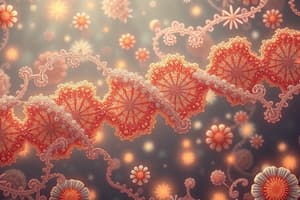Podcast
Questions and Answers
What is the role of DNA in gene expression?
What is the role of DNA in gene expression?
Where does transcription take place?
Where does transcription take place?
Which base is present in DNA but not in RNA?
Which base is present in DNA but not in RNA?
What is the function of ribosomes in translation?
What is the function of ribosomes in translation?
Which process involves aligning transfer RNA carrying specific amino acids based on codons?
Which process involves aligning transfer RNA carrying specific amino acids based on codons?
What are the components of a nucleotide?
What are the components of a nucleotide?
Transcription takes place in the cytoplasm.
Transcription takes place in the cytoplasm.
RNA is single-stranded and contains thymine as one of its bases.
RNA is single-stranded and contains thymine as one of its bases.
DNA serves as the molecule of heredity by passing on genes for making proteins.
DNA serves as the molecule of heredity by passing on genes for making proteins.
Ribosomes function as a ribozyme to form proteins through dehydration synthesis.
Ribosomes function as a ribozyme to form proteins through dehydration synthesis.
Translation occurs in the nucleus on ribosomes.
Translation occurs in the nucleus on ribosomes.
Amaylase is an example of a protein that undergoes processing and secretion for specific functions.
Amaylase is an example of a protein that undergoes processing and secretion for specific functions.
Cells in the body make proteins through gene expression, involving ______ and translation processes.
Cells in the body make proteins through gene expression, involving ______ and translation processes.
DNA is a double-stranded helical molecule with adenine, guanine, cytosine, and ______ bases, while RNA is single-stranded with uracil instead of thymine.
DNA is a double-stranded helical molecule with adenine, guanine, cytosine, and ______ bases, while RNA is single-stranded with uracil instead of thymine.
Transcription starts in the nucleus, where RNA polymerase uses DNA to create messenger RNA (mRNA) by linking nucleotides based on complementary ______ pairing.
Transcription starts in the nucleus, where RNA polymerase uses DNA to create messenger RNA (mRNA) by linking nucleotides based on complementary ______ pairing.
Translation takes place in the cytoplasm on ribosomes, where mRNA is decoded to build proteins by aligning transfer RNA carrying specific amino acids based on ______.
Translation takes place in the cytoplasm on ribosomes, where mRNA is decoded to build proteins by aligning transfer RNA carrying specific amino acids based on ______.
The ribosome functions as a ______, linking amino acids together with peptide bonds to form proteins like amylase.
The ribosome functions as a ______, linking amino acids together with peptide bonds to form proteins like amylase.
DNA serves as the molecule of heredity passing on genes for making RNA and ______ in the body.
DNA serves as the molecule of heredity passing on genes for making RNA and ______ in the body.
Match the following terms with their correct descriptions:
Match the following terms with their correct descriptions:
Match the following components of nucleic acids with their structures:
Match the following components of nucleic acids with their structures:
Match the following processes with their respective locations:
Match the following processes with their respective locations:
Match the following molecular bases with their correct nucleic acids:
Match the following molecular bases with their correct nucleic acids:
Match the following functions with their corresponding molecules:
Match the following functions with their corresponding molecules:
Match the following terms with their correct roles in gene expression:
Match the following terms with their correct roles in gene expression:
Flashcards are hidden until you start studying
Study Notes
- Cells in the body make proteins through gene expression, involving transcription and translation processes.
- Nucleic acids like DNA and RNA play a crucial role in this process, with nucleotides containing a sugar, phosphate group, and nitrogenous base.
- DNA is a double-stranded helical molecule with adenine, guanine, cytosine, and thymine bases, while RNA is single-stranded with uracil instead of thymine.
- DNA serves as the molecule of heredity passing on genes for making RNA and proteins in the body.
- Transcription starts in the nucleus, where RNA polymerase uses DNA to create messenger RNA (mRNA) by linking nucleotides based on complementary base pairing.
- Translation takes place in the cytoplasm on ribosomes, where mRNA is decoded to build proteins by aligning transfer RNA carrying specific amino acids based on codons.
- The ribosome functions as a ribozyme, linking amino acids together with peptide bonds to form proteins like amylase, which are then processed and secreted for specific functions like digesting starch.
Studying That Suits You
Use AI to generate personalized quizzes and flashcards to suit your learning preferences.



